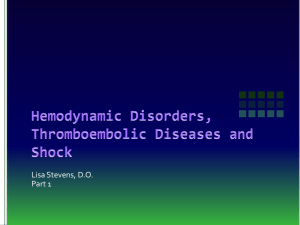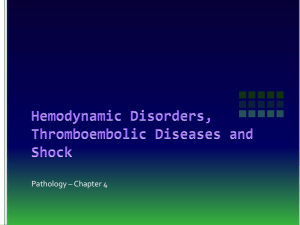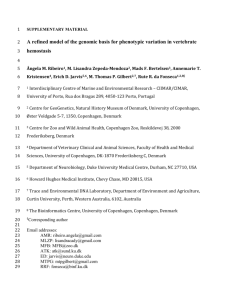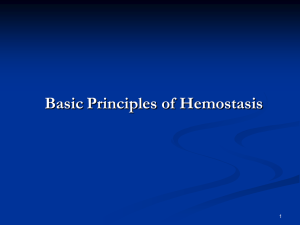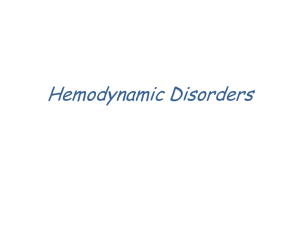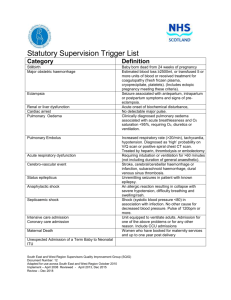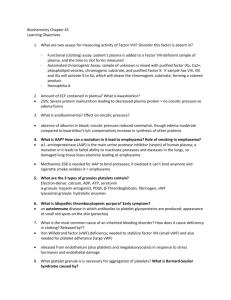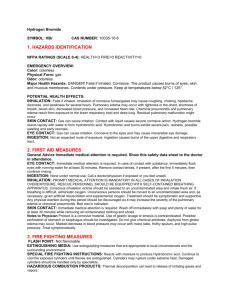Patho Ch4
advertisement
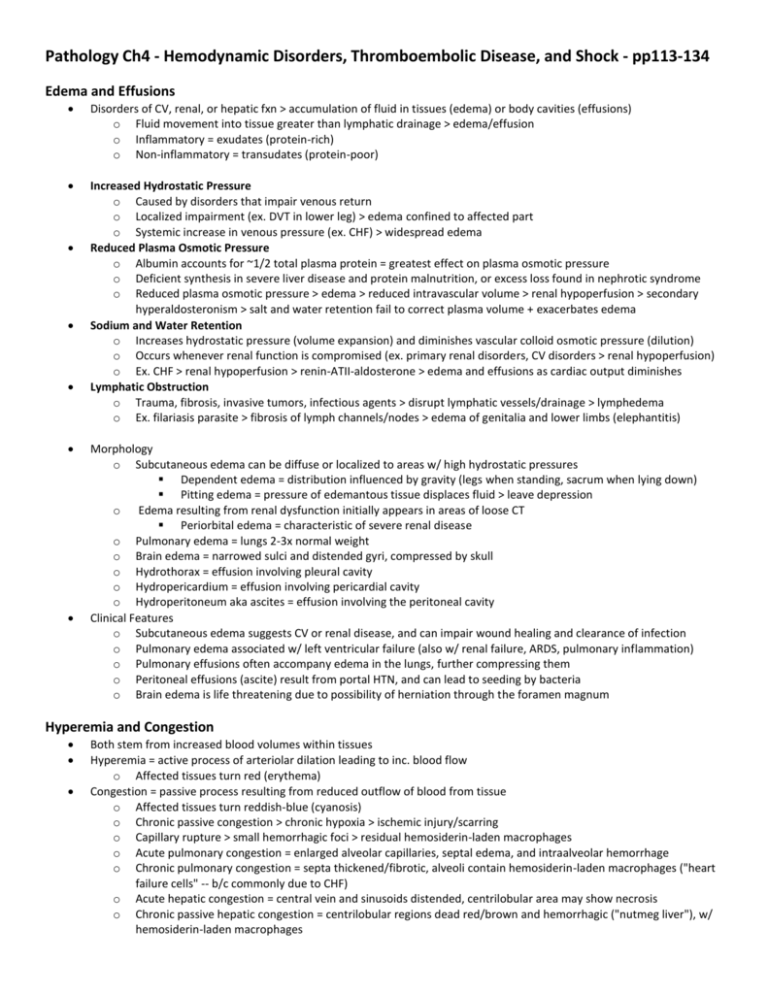
Pathology Ch4 - Hemodynamic Disorders, Thromboembolic Disease, and Shock - pp113-134 Edema and Effusions Disorders of CV, renal, or hepatic fxn > accumulation of fluid in tissues (edema) or body cavities (effusions) o Fluid movement into tissue greater than lymphatic drainage > edema/effusion o Inflammatory = exudates (protein-rich) o Non-inflammatory = transudates (protein-poor) Increased Hydrostatic Pressure o Caused by disorders that impair venous return o Localized impairment (ex. DVT in lower leg) > edema confined to affected part o Systemic increase in venous pressure (ex. CHF) > widespread edema Reduced Plasma Osmotic Pressure o Albumin accounts for ~1/2 total plasma protein = greatest effect on plasma osmotic pressure o Deficient synthesis in severe liver disease and protein malnutrition, or excess loss found in nephrotic syndrome o Reduced plasma osmotic pressure > edema > reduced intravascular volume > renal hypoperfusion > secondary hyperaldosteronism > salt and water retention fail to correct plasma volume + exacerbates edema Sodium and Water Retention o Increases hydrostatic pressure (volume expansion) and diminishes vascular colloid osmotic pressure (dilution) o Occurs whenever renal function is compromised (ex. primary renal disorders, CV disorders > renal hypoperfusion) o Ex. CHF > renal hypoperfusion > renin-ATII-aldosterone > edema and effusions as cardiac output diminishes Lymphatic Obstruction o Trauma, fibrosis, invasive tumors, infectious agents > disrupt lymphatic vessels/drainage > lymphedema o Ex. filariasis parasite > fibrosis of lymph channels/nodes > edema of genitalia and lower limbs (elephantitis) Morphology o Subcutaneous edema can be diffuse or localized to areas w/ high hydrostatic pressures Dependent edema = distribution influenced by gravity (legs when standing, sacrum when lying down) Pitting edema = pressure of edemantous tissue displaces fluid > leave depression o Edema resulting from renal dysfunction initially appears in areas of loose CT Periorbital edema = characteristic of severe renal disease o Pulmonary edema = lungs 2-3x normal weight o Brain edema = narrowed sulci and distended gyri, compressed by skull o Hydrothorax = effusion involving pleural cavity o Hydropericardium = effusion involving pericardial cavity o Hydroperitoneum aka ascites = effusion involving the peritoneal cavity Clinical Features o Subcutaneous edema suggests CV or renal disease, and can impair wound healing and clearance of infection o Pulmonary edema associated w/ left ventricular failure (also w/ renal failure, ARDS, pulmonary inflammation) o Pulmonary effusions often accompany edema in the lungs, further compressing them o Peritoneal effusions (ascite) result from portal HTN, and can lead to seeding by bacteria o Brain edema is life threatening due to possibility of herniation through the foramen magnum Hyperemia and Congestion Both stem from increased blood volumes within tissues Hyperemia = active process of arteriolar dilation leading to inc. blood flow o Affected tissues turn red (erythema) Congestion = passive process resulting from reduced outflow of blood from tissue o Affected tissues turn reddish-blue (cyanosis) o Chronic passive congestion > chronic hypoxia > ischemic injury/scarring o Capillary rupture > small hemorrhagic foci > residual hemosiderin-laden macrophages o Acute pulmonary congestion = enlarged alveolar capillaries, septal edema, and intraalveolar hemorrhage o Chronic pulmonary congestion = septa thickened/fibrotic, alveoli contain hemosiderin-laden macrophages ("heart failure cells" -- b/c commonly due to CHF) o Acute hepatic congestion = central vein and sinusoids distended, centrilobular area may show necrosis o Chronic passive hepatic congestion = centrilobular regions dead red/brown and hemorrhagic ("nutmeg liver"), w/ hemosiderin-laden macrophages Hemostasis, Hemorrhagic Disorders, and Thrombosis Hemostasis o Arteriolar vasoconstriction Occurs immediately > reduces blood flow to injured area Mediated by reflex neurogenic mechanisms + local secretions (ex. endothelin) o Primary hemostasis: formation of platelet plug Disruption of endothelium > expose von Willebrand Factor (vWF) and collagen > activate platelets Activated platelets change shape and release secretory granules to recruit other platelets o Secondary hemostasis: deposition of fibrin Tissue factor at site of injury binds/activates factor VII > cascade > thrombin generation Thrombin cleaves circulating fibrinogen > fibrin > forms meshwork o Clot stabilization and resorption Polymerized fibrin + platelets contract > form solid, permanent plug Counterregulatory mechanisms (ex. tissue plasminogen activator, t-PA) limits clotting to site of injury Counterregulatory mechanisms eventually lead to clot resorption and tissue repair o Platelets Anucleated cell fragments shed from megakaryocytes in bone marrow Form primary plug > provide surface to bind and concentrate activated coagulation factors Function depends on glycoprotein receptors, a contractile cytoskeleton, and 2 cytoplasmic granules α-granules = o Adhesion molecule on membrane (P-selectin) o Coagulation proteins (fibrinogen, factor V, and vWF) o Wound healing proteins (fibronectin, platelet factor 4, PDGF, and TGF-β) Dense (δ-) granules = o ADP and ATP o Ionized Ca++, serotonin, and epinephrine Upon initial contact w/ vWF and collagen > Platelet adhesion o Mediated by interaction w/ vWF + collagen + glycoprotein Ib (GpIb) on platelets Deficiency in vWF (von Willebrand disease) or GpIb (Bernard-Soulier syndrome) Platelets rapidly change shape o Change from smooth discs to spiky balls o Changes in glycoprotein IIb/IIIa > inc. affinity for fibrinogen o Translocation of negatively charged phospholipids to platelet surface > bind Ca++ > site for assembly of coagulation factor complexes Secretion of granule contents o Occurs w/ change in shape ("platelet activation" = change shape + secrete) o Triggered by thrombin and ADP Thrombin > G-protein-coupled receptor (protease-activated receptor PAR) ADP from δ-granules > cycle of activation ("recruitment") o Activated platelets produce thromboxane A2 (TxA2) > induces platelet aggregation Platelet aggregation o Glycoprotein IIb/IIIa allows binding of fibrinogen > bridges adjacent platelets Deficiency in GpIIb-IIIa (Glanzmann thrombasthenia) o Concurrent activation of thrombin > Platelet contraction > stabilizes platelet plug Cleaves fibrinogen > fibrin > secondary hemostatic plug o Coagulation Cascade PT - prothrombin time (extrinsic pathway) Assess factors VII, X, V, II, and fibrinogen Tissue factor + phospholipids + Ca added to plasma > record time for fibrin clot to form o TF > activates VII > activates X > cleaves prothrombin > thrombin > cleaves fibrinogen PTT - partial thromboplastin time (intrinsic pathway) Assess factors XII, XI, IX, VIII, X, V, II, and fibrinogen Add negative-charged particles (ground glass) + phospholipids + Ca > record time to clot o Negative-charged particles activate factor XII (Hageman factor) o XIIa > activates XI > activates IX > combines w/ VIIIa > activates X > cleaves prothrombin o Deficiencies V, VII, VIII, IX, X = moderate/severe bleeding disorders Prothrombin = incompatible w/ life XI = mild bleeding XII = don't bleed (may be susceptible to thrombosis) In Vivo cascade TF complexes w/ VII > activates IX > complexes w/ VIIIa > activates X Thrombin is the most important coagulation factor Conversion of fibrinogen into crosslinked fibrin o Cleaves fibrinogen o Activates XI, and co-factors V and VIII > amplifies coagulation cascade o Activates XIII > cross-links fibrin > stabilizes secondary plug Platelet activation by activating PARs (protease-activated receptors) on platelets Pro-inflammatory effects by activating PARs on inflammatory cells and endothelium Anticoagulant effects upon encountering normal endothelium Factors that limit coagulation Blood flowing past injury site washes out activated coagulation factors > removed by liver Requirement of negatively charged phospholipids only displayed on activated platelets Fibrinolytic cascade limits size of clot and contributes later to dissolution o Factor XII or t-PA convert plasminogen > plasmin o Plasmin breaks down fibrin + interferes w/ polymerization Endothelium Normal endothelial cells express factors that inhibit procoagulant activities Platelet inhibitory effects = o Shield platelets from subendothelial vWF and collagen o Express prostacyclin (PGI2), nitric oxide (NO), and adenosine diphosphatase o Bind and alter activity of thrombin Anticoagulant effects = o Shields coagulation factors from tissue factor in vessel walls o Express thrombomodulin & endothelial protein C receptor > bind thrombin and protein C and directs thrombin's activity toward protein C instead (requires protein S cofactor) o Express heparin-like molecules > activate antithrombin III > inhibit thrombin and IXa, Xa, XIa, and XIIa o Express tissue factor pathway inhibitor (TFPI) > inhibits TF/VIIa complex (also using protein S cofactor) Fibrinolytic effects = synthesize t-PA Injured endothelium or exposure to proinflammatory factors > lose antithrombotic properties Hemorrhagic Disorders o Sudden, massive hemorrhage = aortic dissection (ex. Marfan syndrome), AAA, and MI o Moderate bleeding disorders = coagulation factor deficiencies (ex. hemophilias) o Mild bleeding disorders = vWF defects, aspirin use, and uremia (renal failure) o General principles related to abnormal bleeding: Defects of primary hemostasis (platelet defects or von Willebrand disease) Present w/ small bleeds in skin or mucosal membranes Petechiae (1-2mm) or purpura (>3mm) Mucosal bleeding manifests as epistaxis, GI bleeding, or menorrhagia Fatal complication of thrombocytopenia = intracerebral hemorrhage Defects of secondary hemostasis (coagulation factor defects) Present w/ bleeds in soft tissues or joints (hemarthrosis) Hemarthorosis especially indicative of hemophilia Intracranial hemorrhage may also occur Generalized defects involving small vessels Present w/ palpable purpura and ecchymoses (bruises) Volume of extravasated blood sufficient to create palpable mass (hematoma) Characteristic of systemic disorders (ex. vasculitis or amyloidosis) Thrombosis o Endothelial Injury Exposure of vWF and TF leads to platelet activation Underlies thrombus formation in heart and arteries (high rate of blood flow impedes clot formation) Can also be caused by noxious stimuli or inflammation that shifts endothelium to prothrombotic state Ex. physical injury, infectious agents, abnormal blood flow, inflammatory mediators, metabolic abnormalities (hypercholesterolemia or homocystinemia) and toxins absorbed from cigarettes Procoagulant changes = Activated by cytokines > downregulate thrombomodulin expression Activated by inflammation > downregulate protein C and TFPI Antifibrinolytic effects = Activated endothelial cells > secrete plasminogen activator inhibitos (PAIs) Limit fibrinolysis and downregulate t-PA expression o Alternations in Normal Blood Flow Turbulence > local packets of stasis Promote endothelial activation, enhance procoagulant activity, and leukocyte adhesion Disrupt laminar flow > bring platelets in contact w/ endothelium Prevent washout and dilution of activate clotting factors Aneurysms (dilations in aorta/arteries) > local stasis Acute MI > noncontractile myocardium + cardiac aneurysms > stasis > cardiac mural thrombi Rheumatic mitral valve stenosis > left atrial dilation > stasis Hyperviscosity > inc. resistance to flow > small vessel stasis Sickle cell anemia > deformed RBC > impede blood flow through small vessels > stasis o Hypercoagulability (aka thrombophilia) Primary (genetic) disorders Common: Factor V mutation, prothrombin mutation, inc. levels of VIII, IX, XI, or fibrinogen Rare: antithrombin III deficiency, protein C deficiency, protein S deficiency Very rare: fibrinolysis defects, homozygous homocystinuria Secondary (acquired) disorders High risk: prolonged bed rest/immobilization, MI, AFib, tissue injury, cancer, prosthetic cardiac valves, DIC, heparin-induced thrombocytopenia, antiphospholipid antibody syndrome Low risk: cardiomyopathy, nephrotic syndrome, hyperestrogenic states & oral contraceptives (inc. hepatic synthesis of coagulation factors), sickle cell anemia, smoking Factor V Leiden Mutation in factor V affecting 2-15% Caucasians Found in 60% of pts w/ recurrent DVT Mutation renders factor V resistant to cleavage and inactivation by protein C > loss of antithrombotic counterregulatory pathway Heterozygotes > 5x risk of venous thrombosis; Homozygotes > 50x risk Prothrombin Mutation (G20210A) Mutation in 1-2% of population Leads to elevated prothrombin levels > 3x risk of venous thrombosis Elevated Homocysteine Caused by mutation leading to deficiency of cystathione β-synthetase Thioester linkages formed between homocysteine metabolites and fibrinogen Heparin-Induced Thrombocytopenia (HIT) Syndrome Follows administration of unfractionated heparin Induce antibodies that recognize complexes of heparin:platelet factor 4 on platelet surfaces Results in activation, aggregation, and consumption of platelets (thrombocytopenia) Low-molecular-weight heparin preparations induce HIT less frequently Antiphospholipid Antibody Syndrome (aka Lupus Anticoagulant Syndrome) Recurrent thromboses, repeated miscarriages, cardiac valve vegetation, and thrombocytopenia Can also cause PE, pulmonary HTN, stroke, bowel infarction, and renovascular HTN Binding of antibodies to epitopes on proteins unveiled by phospholipids (β2-glycoprotein I) Rx: anticoagulation and immunosuppression o o o Morphology Arterial thrombi begin at sites of turbulence or endothelial injury > grow retrograde Venous thrombi begin at sites of stasis > extend in direction of blood flow Laminations (lines of Zahn) = pale platelet/fibrin deposits alternating w/ darker RBC-rich layers Mural thrombi = occur in heart chambers or in aortic lumen Heart valve thrombi (vegetations) = from infectious endocarditis or nonbacterial thrombotic endocarditis/Libman-Sacks endocarditis Arterial thrombi = frequently occlusive (common in coronary, cerebral, and femoral aa.) Venous thrombi (phlebothrombosis) = invariably occlusive Fate of the Thrombus Propagation = thrombi accumulate platelets and fibrin Embolization = thrombi dislodge and travel to other sites Dissolution = fibrinolysis > shrinkage/disapperance of thrombi (older thrombi more resistant to t-PA) Organization and recanalization = older thrombi organized by ingrowths of endothelial cells, SM cells, and fibroblasts > become incorproated into vessel wall Clinical Features Venous thrombosis (phlebothrombosis) Most occur in superficial or deep veins of legs Superficial typically in saphenous vein in setting of varicosities > local congestion, swelling, pain, and tenderness, but rarely embolize. May lead to infections and ulcers (varicose ulcers). Deep vein thrombosis (DVT) more often embolize to the lungs > pulmonary infarction o Asymptomatic in 50% of pts > not recognized until embolization o Associated w/ hypercoagulable states o Predisposing factors = bed rest/immobilization, CHF, trauma/surgery/burns, pregnancy, old age, and tumor-associated inflammation and coagulation factors (migratory thrombophlebitis/Trousseau syndrome) Arterial and cardiac thrombosis Atherosclerosis associated w/ loss of endothelial integrity and abnormal blood flow MI and rheumatic heart disease can predispose to cardiac mural thrombi Cardiac and aortic mural thrombi are prone to embolization > brain, kidneys, spleen Disseminated Intravascular Coagulation o Complication of a large number of conditions associated w/ systemic activation of thrombin o Leads to widespread formation of thrombi in the microcirculation o Cause diffuse circulatory insufficiency and organ dysfunction (esp. brain, lungs, heart, and kidneys) o Thrombosis uses up platelets and coag factors > bleeding catastrophe > hemorrhagic stroke or hypovolemic shock Embolism Pulmonary Embolism o Most common form of thromboembolic disease o Pts who had one PE are at high risk for more o 95% originate from DVT > right side of heart > lodge in pulmonary aa. Can occlude the main pulmonary artery, straddle the bifurcation (saddle embolus), or pass to smaller aa. o Can rarely pass through atrial/ventricular defects > lodge in arterial circulation (paradoxical embolism) o Major functional consequences of PE: 60-80% are clinically silent due to small size Can lead to sudden death, right heart failure, or CV collapse when obstructing >60% of pulmonary circ. Obstruction of medium-sized aa. > vascular rupture > pulmonary hemorrhage (but no infarction) Obstruction of small end-arteriolar pulmonary branches > hemorrhage or infarction Multiple emboli over time > pulmonary HTN and right ventricular failure Systemic Thromboembolism o 80% arise from intracardiac mural thrombi 2/3 associated w/ L ventricular wall infarcts 1/4 associated w/ L atrial dilation/fibrillation o Remainder from aortic aneurysms, atherosclerotic plaques, valvular vegetations, or paradoxical emboli o Most come to rest in lower extremities (75%) or brain (10%) o Can also come to rest in intestines, kidneys, spleen, and upper extremities o Outcome depends on size of emboli, diameter of vessel occluded, and collateral circulation Fat and Marrow Embolism o Can be found in pulmonary vasculature after fractures of long bones o Rupture of vascular sinusoids in marrow > release marrow or adipose tissue into vasculature o Occur in 90% of severe skeletal injuries, but <10% have clinical findings o Fat embolism syndrome = symptomatic 10% Pulmonary insufficiency, neurologic symptoms, anemia, thrombocytopenia, 5-15% fatality 1-3 days after injury > onset of tachypnea, dyspnea, and tachycardia Irritability and restlessness can progress to delirium/coma Diffuse petechial rash (20-50%) related to thrombocytopenia = useful for diagnosis Air Embolism o Gas bubbles in circulation can coalesce > frothy masses > obstruct vascular flow > distal ischemic injury Can be introduced into cardiac/cerebral circulation by surgery (only small amount of air required) Can be introduced into pulmonary circulation by laproscopic or chest wall surgery (>100cc required) o Decompression sickness = sudden decrease in atmospheric pressure (scuba or deep sea divers coming up fast) Rapid depressurization > nitrogen comes out of solution in tissue and blood Caisson disease = chronic form of decompression sickness, persistence of gas emboli in skeletal system > multiple points of ischemic necrosis (commonly femoral heads, tibia, and humeri) Rx: pts placed in high pressure chamber > get gasses back into solution > slow decompression o "The bends" = formation of gas bubbles in skeletal muscle and supporting tissues of joints o "The chokes" = formation of gas bubbles in lung vasculature > respiratory distress Amniotic Fluid Embolism o 5th most common cause of maternal mortality worldwide o 10% of pregnancy deaths in US > 85% of survivors have permanent neurologic deficit o Infusion of amniotic fluid/fetal tissue into maternal circulation via tear in placenta or rupture of uterine veins o Activation of coag factors and components of innate immune system by amniotic fluid (not a mechanical blockage) o Onset sudden severe dyspnea, cyanosis, and shock > neurlogic impairment (headaches/seizures/coma) o Survival of initial symptoms > pulmonary edema develops + DIC Infarction Area of ischemic necrosis caused by occlusion of arterial supply or venous drainage Arterial thrombosis or arterial embolism underlies majority of infarctions Morphology o Red infarcts (hemorrhagic) - venous occlusions Venous occlusions Loose/spongy tissues where blood can collect in the infarcted zone (eg. lung) Tissues w/ dual circulations that allow blood to flow into necrotic zone (eg. lung and small intestine) Tissues previously congested by sluggish venous outflow When flow is reestablished to site of previous arterial occlusion and necrosis o White infarcts (anemic) - arterial occlusions Arterial occlusions in solid organs w/ end-arterial circulation (eg. heart, spleen, kidney) Where tissue density limits the seepage of blood from adjoining capillary beds into necrotic area o Tend to be wedge-shaped, w/ occluded vessel at apex o Dominant characteristic = ischemic coagulative necrosis (except in brain > liquefactive necrosis) o Septic infarctions = infected cardiac valve vegetations embolize or microbes seed necrotic tissue > infarct converted into abscess Factors that influence development of an infarct o Anatomy of the vascular supply = availability of alternative blood supply o Rate of occlusion = slow occlusions less likely to cause infarction (time to develop collateral circulation) o Tissue vulnerability to hypoxia = neurons (3-4 min), myocardial cells (20-30 min), fibroblasts (hours) o Hypoxemia = abnormally low blood O2 increases likelihood and extent of infarction Shock Diminished cardiac output or reduced effective circulating blood volume impairs tissue perfusion > cellular hypoxia Reversible at onset, but prolonged shock leads to irreversible injury/death Cardiogenic shock o Results from low cardiac output due to myocardial pump failure o Due to MI, ventricular arrhythmias, extensive compression (cardiac tamponade), or outflow obstruction (PE) Hypovolemic shock o Results from low cardiac output due to low blood volume o Due to massive hemorrhage or fluid loss from severe burns Shock associated w/ systemic inflammation o May be triggered by microbial infections, burns, trauma, or pancreatitis o Leads to outpouring of inflammatory mediators > arterial vasodilation, vascular leakage, venous blood pooling o Result in tissue hypoperfusion, cellular hypoxia, and metabolic derangements > organ dysfunction/failure/death Septic shock = caused by microbial infection Neurogenic shock = anesthetic accident or spinal cord injury Anaphylactic shock = IgE-mediated hypersensitivity reaction Pathogenesis of Septic Shock o Most common cause of death in ICUs (20% mortality rate) o Most frequently triggered by gram-positive bacterial infections (followed by gram-negative, then fungi) o Inflammatory and counter-inflammatory responses Microbial cell wall constituents (PAMPs) engage innate immune system > pro-inflammatory TNF, IL-1, IFN-γ, IL-12, IL-18, HMGB1, ROS, prostaglandins, PAF > endothelial cells upregulate adhesion molecule expression > further stimulate cytokine and chemokine production Complement activation > anaphylotoxins (C3a, C5a), chemotactics (C5a), and opsonins (C3b) Activate coagulation directly via factor XII + indirectly through altered endothelial function Hyperinflammatory state activates counter-regulatory immunosuppressive state > pts oscillate between hyperinflammatory and immunosuppressed states Shift from pro-inflammatory TH1 to anti-inflammatory TH2 Production of anti-inflammatory mediators (TNF receptor, IL-1 receptor antagonist, IL-10) Lymphocyte apoptosis and induction of cellular anergy o Endothelial activation and injury Leads to widespread vascular leakage and tissue edema > impedes tissue perfusion Upregulates production of nitric oxide (NO) and other vasoactive inflammatory mediators > vascular SM relaxation > systemic hypotension o Induction of a procoagulant state Produces complication of DIC in up to 1/2 of septic pts Leads to systemic activation of thrombin and deposition of fibrin-rich thrombi in small vessels > further complicate tissue perfusion o Metabolic abnormalities Septic pts exhibit insulin resistance and hyperglycemia > dec. neutrophil function Cellular hypoxia and diminished oxidative phosphorylation > inc. lactate production > lactic acidosis o Organ dysfunction Systemic hypotension + interstitial edema + small vessel thrombosis > decrease O2/nutrient delivery High levels of cytokines and secondary mediators > diminish myocardial contractility and cardiac output Increased vascular permeability and endothelial injury > acute respiratory distress syndrome >>> Multiple organ failure (esp. kidneys, liver, lungs, heart) > death o Rx: antibiotics, IV fluids, and supplemental oxygen Stages of Shock o Nonprogressive phase = reflex compensatory mechanisms > perfusion of vital organs maintained Baroreceptor reflexes, catecholamine release, renin-angiotensin, ADH release, sympathetic stimulation Net effect = tachycardia, peripheral vasoconstriction, and renal conservation of fluid o Progressive phase = tissue hypoperfusion + worsening circulatory and metabolic imbalances Widespread tissue hypoxia > shift to anaerobic glycolysis > excess lactic acid production Lactic acidosis > lower tissue pH > blunts vasomotor response > arterioles dilate > blood pools in microcirculation > lowers cardiac output and raises risk of DIC Vital organs begin to fail o Irreversible stage = cellular and tissue injury too severe to recover Lysosomal enzyme leakage > further aggravates shock state Ischemic bowel may allow intestinal flora to enter circulation > superimposed bacteremic septic shock Pt may develop anuria as a result of acute tubular necrosis and renal failure Eventually results in death Morphology o Cellular and tissue changes essentially those of hypoxic injury o Changes particularly evident in brain, heart, lungs, kidneys, adrenals, and GI tract Adrenals = cortical cell lipid depletion Kidneys = acute tubular necrosis Lungs = diffuse alveolar damage when shock caused by sepsis or trauma (shock lung) o Development of DIC > deposition of fibrin-rich microthrombin in brain, heart, lungs, kidney, adrenal glands, and GI o Consumption of platelets and coag factors > petechial hemorrhages on serosal surface of skin Clinical Consequences o Hypovolemic and cardiogenic shock = hypotension, weak/rapid pulse, tachypnea, coolclammy/cyanotic skin o Septic shock = skin initially warm due to vasodilation > cardiac, cerebral, and pulmonary dysfunction > electrolyte disturbances and metabolic acidosis > renal insufficiency > severe fluid and electrolyte imbalances
